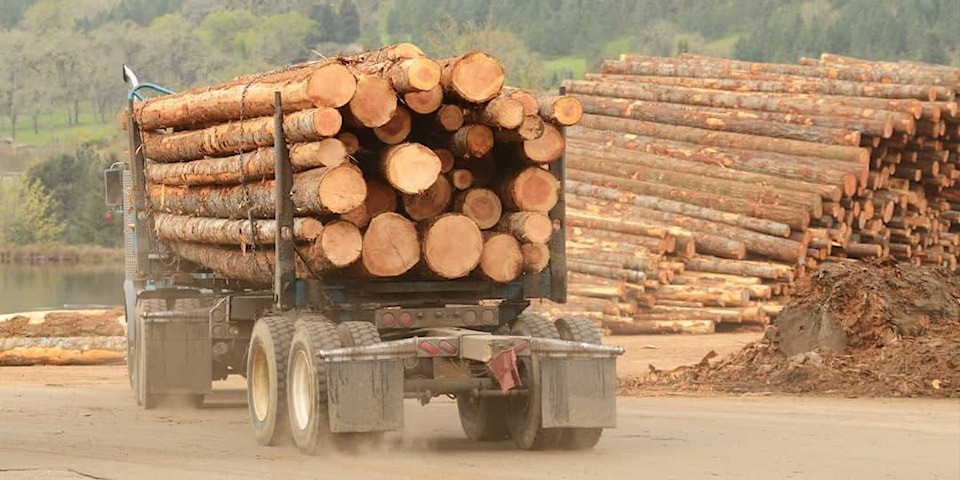The prospect of a stumpage rate increase July 1 has industry representatives and elected officials worried about what that means for the forest industry.
With B.C. already labelled as one of the more uncompetitive forest industry sectors in North America because of high logging and processing costs, having to pay the province more for timber that’s harvested is leading to fears of additional closures and production cutbacks.
“From what we’re hearing from licensees, from the industry, from contractors, the feeling is that stumpage is going up July 1. But by how much, no one knows at this time,” says Todd Chamberlain, the assistant general manager of the Interior Logging Association which represents logging contractors through a broad swath of B.C.
“It’s a concern for us for sure. We’ve already seen curtailments at mills, including Canfor, and increased prices is something we don’t need right now.”
“And now, with the wildfire season upon us, there’s the additional worry of shut downs in the bush. We’re operating in a very difficult climate right now.”
Houston has not been spared from temporary mill closures with Canfor undertaking several week-long shutdowns since the fall across its B.C. operations, including an extended Christmas break.
Chamberlain’s also not surprised that the local Canfor mill has reduced the volume of logs it’s taking into its yard this spring.
The company reported a first quarter of 2019 operating loss of $69.9 million which, while still a loss, was an improvement of the $79.1 million operating loss for the same period in 2018.
Its production cuts last year and into this year were an attempt to reduce supply and, subsequently, increase the selling price of its products.
That did work, the company said in reporting its first quarter results, although a slower increase in spring building activity than anticipated caused prices to then slip.
Chamberlain said the logging industry understands the need for initiatives announced by the province to increase the utilization of the trees that are cut to provide more pulp or fibre for the biomass industry.
But taking what was once considered waste as part of the overall harvest adds costs which cannot always be recouped, he said.
“We’ve asked to be included but have had no response yet,” said Chamberlain of wanting to be involved in provincial policy decision making.
“There’s been no discussion paper yet, no terms of reference.”
Nechako Lakes B.C. Liberal MLA John Rustad, his party’s forestry critic and whose riding takes in Houston, is also zeroing in on a July 1 stumpage increase as a significant concern.
“There needs to be a complete rethink. You don’t see mills closing in Alberta or Ontario and there’s a reason for that. We’re just not competitive in B.C.,” he said.
“I’m not surprised that mills are choosing now to draw down on their inventory.”
Added to the worries of a stumpage rate increase are softwood lumber duties to the United States and potential reductions in various parts of B.C. to annual allowable cuts which would further reduce the timber supply for mills.
Rustad supports increased utilization of every tree so that sawmills, pulpmills and other users have a supply of fibre.
“If we can cut the waste now by half, to six million cubic metres of wood, for instance that will create a number of jobs,” he said.
But he warns there’s the danger of a trade off where one portion of the woods industry could benefit to the detriment of other fibre users.
“Right now there’s a lack of clarity,” Rustad added of what the province’s forest policy will look like.
“And that creates uncertainty and with uncertainty and with increased costs you could see zero investment on the part of companies,” he said.
Rustad points to European countries such as Finland and Sweden where although the forest base is smaller, there’s a greater harvest volume than in B.C. because of balanced increased utilization.
Canfor itself focused on Sweden with the purchase last year of 70 per cent of the Vida group, Sweden’s largest privately-owned sawmill company.
Profits from that acquisition in the first quarter of this year helped buffer loses from other Canfor operations.
An official from Canfor declined to directly comment on the company’s log acquisitions this spring.
“For all of our B.C. sawmills, Canfor is closely monitoring market demand and the price of lumber and we are continually assessing those factors against our operating capacity,” said Michelle Ward.
